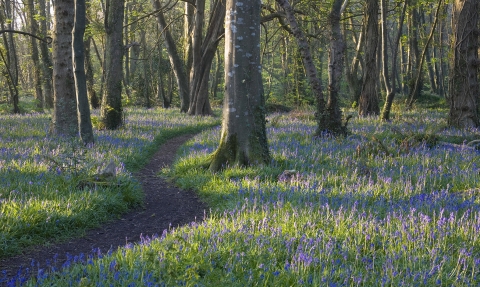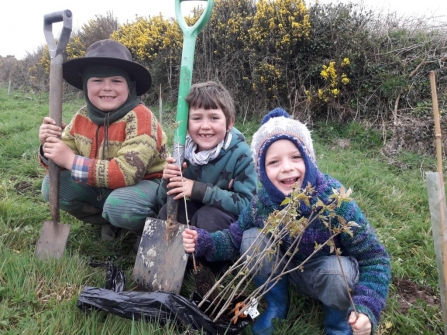
Tree Planting
Tree planting as a natural solution to climate change is receiving a lot of attention at the moment and for good reason. Woodlands store more carbon than other habitats and the carbon store builds up over decades as wood is formed. Woodland has an additional benefit for climate change mitigation in that wood fuel and forest products can substitute for fossil fuels and high carbon-emission building materials like concrete.
The UK Government’s Committee on Climate Change has said that 30,000 hectares (116 sq miles) of new trees are needed per year until 2050. The Government responded last November by launching a £50 million Woodland Carbon Guarantee scheme to encourage farmers and landowners to plant more trees. Locally, Cornwall Council’s ambition under the ‘Forest for Cornwall’ banner is an increase of 8,000 hectares of tree cover by 2030, this will cover 2% of Cornwall’s land area.

Willbur, Alice and Felix tree planting
So, like-it-or-not a significant amount of tree planting is coming to Cornwall. The Trust has produced some tree planting guidance to help people to make the right decisions on when, where and how to increase tree cover. A big concern amongst nature conservationists is trees being planted into existing habitats such as species-rich grassland that already support numerous wildlife species. Over time the change in management (like exclusion of grazing animals) and shading from the trees makes the habitat unsuitable for many species and the biodiversity of the site declines. There are numerous examples of this already in Cornwall, and that was before the recent mass-interest in tree planting.
To the untrained eye, an area of grassland might look unimpressive in the middle of winter and be earmarked for well-intentioned tree planting, yet in summer it may be bursting with wild flowers, bumblebees and birds and be vitally important in its own right. This is why it is so important to know what you are planting into; ideally we would target areas that are the wildlife equivalent of a ‘blank canvas’, like an unproductive corner of an intensive silage field. Trees can even be positioned to help deliver other benefits like slowing the flow of surface water to help reduce flooding or provide shelter for livestock.
Here's Liz to explain more:
Children tree planting - Sarah Clappison
The way in which trees are introduced to a site is also up for debate. The conventional method of planting tree nursery stock and protecting with plastic tree guards is coming under increasing scrutiny. The argument is that natural regeneration (germination of seed already present in the area) is a better option. Natural regeneration is likely to be lower cost and ensures that the resultant trees and shrubs are well-suited to the local soil and weather conditions.
If tree planting is being planned in your area, please ask if they have had advice from an experienced ecologist and tell them about our tree planting guidance; some of Cornwall’s most sensitive wildlife habitats may depend on it.
